Why Do Some Birds Form Mixed-Kin Groups?
Shailee Shah, GSAS'22, explains why superb starlings may have evolved to live in groups in which unrelated birds help raise others' offspring.
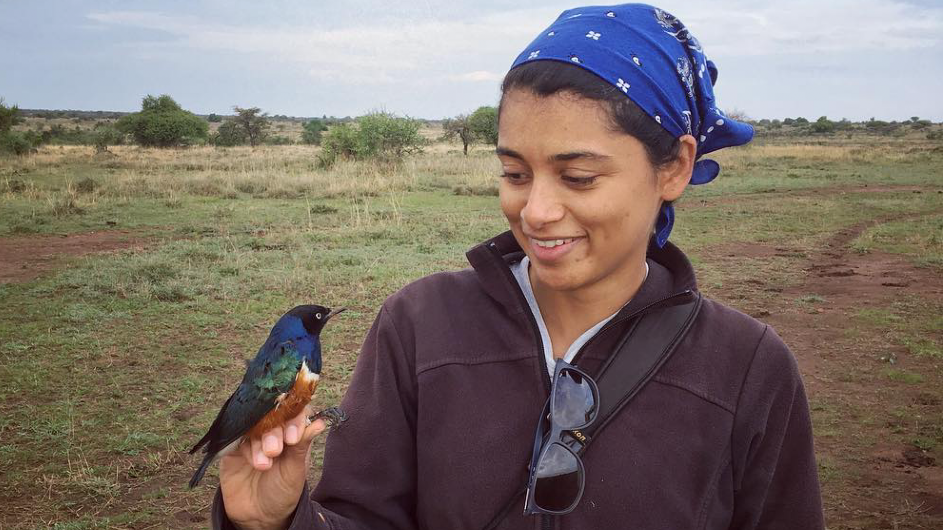
Birds caught Shailee Shah’s eye from an early age. When she wasn’t watching Animal Planet reruns, she was perched on her parents’ roof in Ahmedabad, studying the city’s rose-ringed parakeets as they darted in and out of their tree hole nests. When Shah left India for college, at Cornell, it made sense that she’d find her way to the Cornell Lab of Ornithology, where she launched her research career by studying the alarm calls of herring gulls.
After graduating, Shah tried her hand at making bird-related documentaries. Then she learned about Dustin Rubenstein’s long-term study of superb starlings, a highly social bird that lives on the East Africa savannah. He was taking PhD students and she wanted in. “Superb starlings don't fit the mold of cooperative breeders that I learned about in college, and I wanted to figure out why!” she said.
Five years later, Shah has put forth an idea for why superb starlings live in cooperative “mixed-kin” groups of closely related birds and those that have immigrated in from other social groups. Biologists once thought that about 90 percent of cooperative breeders were closely related, and thus benefited directly from helping their kin pass on their genes. But genetic sequencing has shown otherwise. Nearly half of cooperatively breeding birds now appear to live in groups of birds that are either totally unrelated or, like the starlings, made up of related and unrelated individuals.
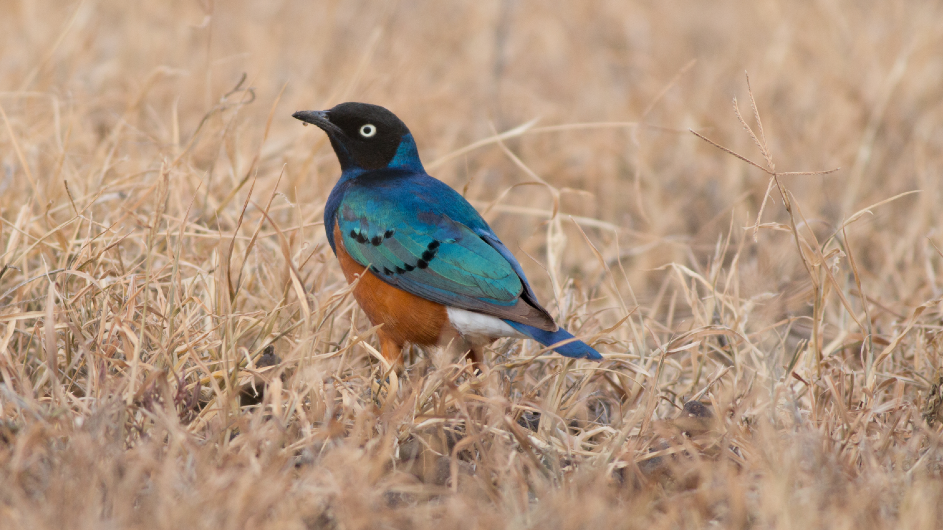
“In many ways, the complexity of superb starlings’ mixed-kin societies look more like humans than almost any other animal on Earth” said Rubenstein, a professor of behavioral and evolutionary biology at Columbia.
In a new study in Science Advances, Shah and Rubenstein explain why mixed-kin groups like the starlings may form and how they remain stable, despite the potential for conflict among unrelated birds. In an interview with Columbia News, Shah breaks down their results, shares a few of the challenges she faced, and offers advice to aspiring biologists.
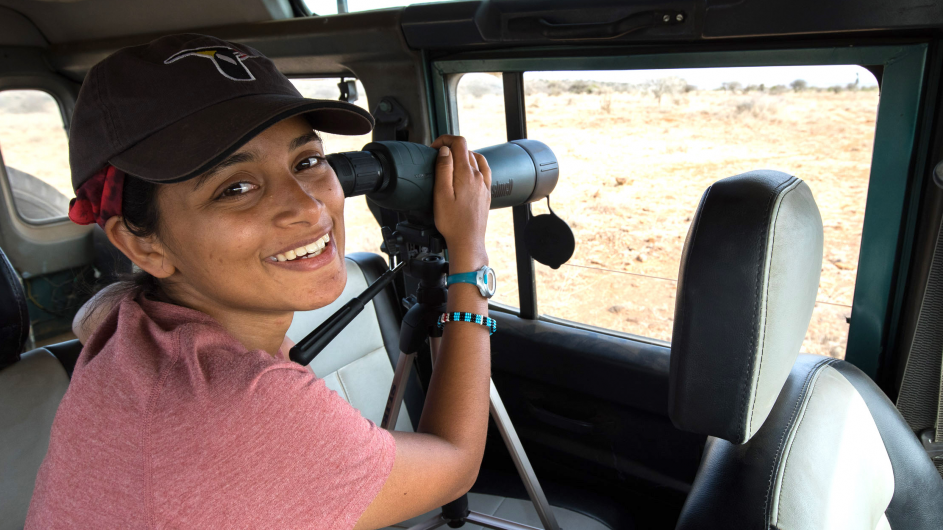
What’s the mystery at the heart of this paper?
Superb starlings are cooperative breeders, like about 9 percent of all birds. They live in groups in which one or more unrelated birds called “helpers” feed and protect the chicks in a nest. We used to think that cooperative breeders lived in groups of closely related individuals but today we’re finding more and more helpers that are genetically unrelated to the offspring they help raise.
The mystery is why would mixed-kin groups be adaptive when we know from studies going back decades in animals as diverse as insects and vertebrates that living among relatives is often critical to the evolution of complex societies. From previous research, we had a hunch that the environment played a role. Superb starlings live in a part of East Africa with considerable year-to-year variation in rainfall. Relatively few chicks survive to adulthood. About 70 percent of nests fail completely because the chicks either starve or are eaten by snakes, hawks, and other predators.
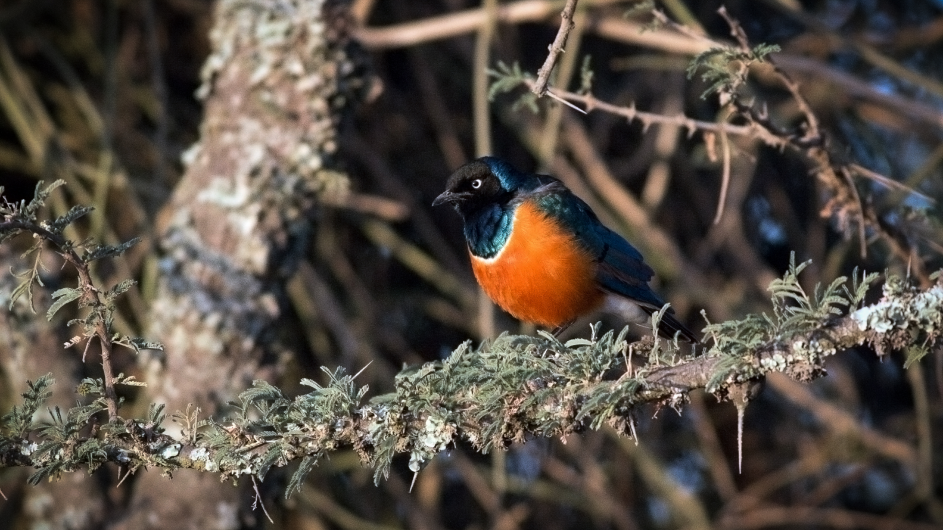
Why did your study focus on superb starling males?
Males are equally likely to breed whether they stay within the group they were born into or disperse, unlike females who are more likely to disperse and breed only after joining a new group. We wanted to know why some males choose to disperse while others stay put. We also wanted to know if both tactics lead to equivalent fitness, and could explain why mixed-kin groups are adaptive.
How did you tell the males from the females?
You can’t tell by looking at them—both sexes have shimmering, iridescent plumage. We collected a small blood sample to identify their sex from their genotype: females have two different sex chromosomes (ZW) while males have two of the same chromosomes (ZZ). It’s the opposite of mammals, where males are XY and females XX.
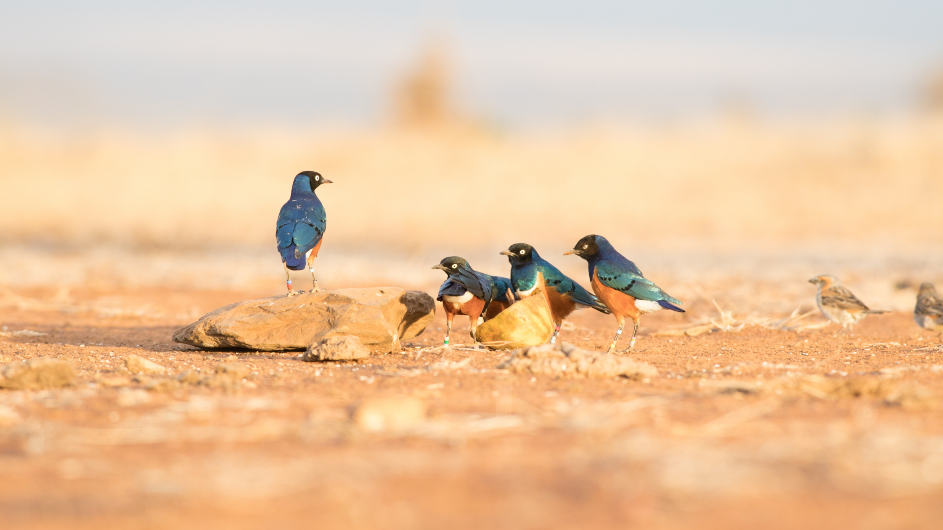
What are the study’s main results?
First, we found that the parent’s pre-breeding environment—the ecological conditions they experience before the breeding season even begins—determined whether male chicks would leave the group. When parents experienced heavy rainfall, male chicks were more likely to disperse as adults. In contrast, when parents experienced dry, unfavorable conditions, males were more likely to stay. Second, we found that males that adopted the dispersal tactic predicted by the pre-breeding environment of their parents were more likely to accrue some “inclusive” fitness (defined as the sum of “indirect” fitness gained from helping relatives and “direct” fitness from successfully fledging their own offspring) in their lifetime. Overall, we found that both males that dispersed and males that remained in their natal group had equivalent fitness, on average, in their lifetime. Our results suggest that both dispersal tactics may be maintained because different tactics lead to higher fitness in different years, depending on rainfall.
What’s the most important takeaway from your study?
In behavioral ecology, focus is shifting away from indirect fitness as a complete explanation for the evolution of complex societies. Ours is one of the first studies to leverage lifetime fitness data from a cooperatively breeding species to suggest that indirect fitness is not the main force driving dispersal decisions. Our results also suggest that more complex cooperative groups, made up of unrelated and closely related birds, can thrive when both tactics lead to equivalent fitness.
You spent more than a year in the field, at Kenya’s Mpala Research Centre. What was the best/worst part?
Best: seeing giraffes, zebras, antelopes, the occasional lion, and so many cool birds. Worst: trying to trap the starlings. They quickly caught on to our simple, pull-string traps and sometimes even alarm called if a less wary member of their group ventured into the trap. It was a real exercise in patience.
What was your biggest challenge in doing this research?
Having access to 16 years of data was crucial to calculating lifetime fitness in these long-lived birds. But working with such a large dataset as a newbie programmer was less than ideal. Filtering the data correctly, and incorporating checks each time I manipulated the data, was painstakingly difficult.
How did you push through?
I asked for help. For two years I struggled with the data before mentioning my difficulties to Jo Jensen, my roommate and fellow E3B grad student. She sat down and helped me write the code that answered all my prayers in under an hour. It boosted my R programming skills and made analyzing the remaining data in my dissertation so much easier.
What’s your next career step?
After defending my dissertation in December, my goals were to catch up on sleep and fly to India to visit my parents who I hadn't seen since the start of the pandemic. I just returned, and next month I start a postdoctoral fellowship in Dr. Nancy Chen's lab at the University of Rochester, focused on another cooperative breeder, the Florida scrub-jay.
Any advice for aspiring biologists?
Ask for help when you need it. As Alie Ward, the host of Ologies, my favorite podcast, says: “Ask smart people stupid questions.” I’ve wasted so much time and energy trying to solve problems like reorganizing a large dataset or getting my car out of the mud on my own. Everyone has different skills. In my opinion, the best science is done in a community, not in isolation.